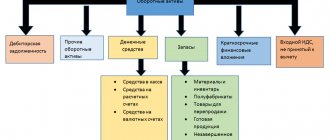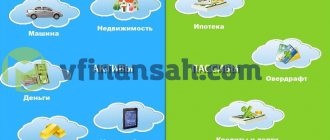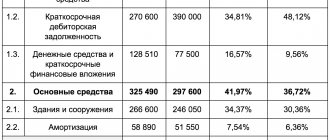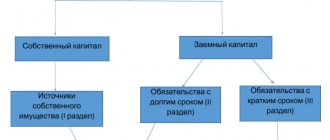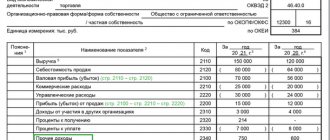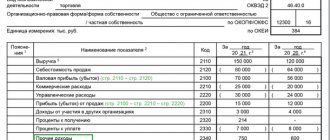Equality is an asset
The equality of assets and liabilities is also due to the double entry of transactions on accounts, according to which the total of the debit is equal to the total of the credit of the entire set of accounts.
[1] The equality of an asset to a liability is called balancing. [2]
The equality of Asset and Liability in a natural balance is possible only in a special case that is not of interest for theoretical research. [3]
What causes the equality of assets and liabilities of the balance sheet. [4]
What determines the equality of assets and liabilities of the balance sheet. [5]
When equality of assets and liabilities is achieved, the balance is considered liquid. [6]
CLOSED CURRENCY POSITION - equality of assets and liabilities, as well as off-balance sheet claims and liabilities, in a specific foreign currency. [7]
Duality in accounting provides for the mandatory equality of the organization's assets with the sources of their formation at any date of the organization's functioning. [8]
The use of dummy accounts leads to the equality of Asset and Liability. [9]
Andrew had heard of this principle of asset-liability equality before, but did not understand how it could apply to him personally. [10]
During various business transactions, specific amounts in certain accounts change, but the equality of assets and liabilities is not violated. For each account, a statement is kept that records the inflow and outflow of funds from this account. At the end of each month, on the basis of statements, order journals are compiled, which take into account the total inflow and outflow of funds for each account or group of accounts. Based on the journal orders, at the end of the reporting period, entries are made in the General Ledger and the balance sheet of the enterprise is compiled. [eleven]
LIQUIDITY OF THE BANK'S BALANCE SHEET - the ratio between the assets and liabilities of the bank's balance sheet for certain periods of time; when equality of assets and liabilities is achieved, the balance sheet is considered liquid. [12]
In this statement, the balance at the beginning of the month in debit must be equal to the balance at the beginning of the month in credit, which is due to the equality of the assets and liabilities of the balance sheet at the beginning of the month according to which the accounts were opened. [13]
Accountants are concerned with the fulfillment of Pacioli's postulates, because they control the correctness of the monetary valuation in which the balance sheet is prepared [3], hence its definition as the equality of assets and liabilities. [14]
As follows from the data in the table, the total balances at the beginning and end of transactions on the debit and credit of accounts are equal to each other, which follows from the equality of the assets and liabilities of the balance sheet. The totals of turnover in the debit and credit accounts are also equal, which follows from the double entry method. [15]
Conclusions about what a change in indicator means
If the indicator is higher than normal
Not standardized
If the indicator is below normal
Not standardized
If the indicator increases
If the organization's assets and liabilities increase (while remaining, of course, equal to each other), this is usually a positive factor, especially if it is accompanied by faster growth in revenue and profit and occurs from its own sources of financing (section 3).
Otherwise, it is a negative factor.
If the indicator decreases
If the assets and liabilities of an organization decrease (while remaining equal to each other), then this is usually a positive factor if it is accompanied by an increase in revenue and profit, especially if long-term and, especially, short-term liabilities are reduced.
Otherwise, it is a negative factor, especially if revenue and profit are declining faster than the balance sheet total of assets and liabilities is declining.
Notes
The indicator in the article is considered from the point of view not of accounting, but of financial management. Therefore, sometimes it can be defined differently. It depends on the author's approach.
In most cases, universities accept any definition option, since deviations according to different approaches and formulas are usually within a maximum of a few percent.
The indicator is considered in the main free online financial analysis service and some other services
If you need conclusions after calculating the indicators, please look at this article: conclusions from financial analysis
If you see any inaccuracy or typo, please also indicate this in the comment. I try to write as simply as possible, but if something is still not clear, questions and clarifications can be written in the comments to any article on the site.
Best regards, Alexander Krylov,
The financial analysis:
- Balance sheet liability The balance sheet liability is the second part of the balance sheet. It contains a list of those financial resources that were used to acquire property, that is, assets that...
- Balance sheet asset A balance sheet asset is a part of the balance sheet containing data on the assets of the enterprise, that is, on its property. The balance sheet asset reflects property, property rights and cash...
- I. NON-CURRENT ASSETS Non-current assets are property used in the activities of an enterprise for more than a year. Its value is transferred in parts to the cost of finished products. A sign of assets is the ability to generate income for the organization.…
- III. CAPITAL AND RESERVES Section III Capital and Reserves is the third section of the balance sheet. But what is more important is the first section of financial sources, that is, the liability side of the balance sheet. By this he...
- V. CURRENT LIABILITIES Section V. Current liabilities is the fifth section of the balance sheet. At the same time, it is also the third section of the liability side of the balance sheet, which shows the sources of financing for the property. AND…
- Key performance indicators of an enterprise Key performance indicators of an enterprise are indicators that allow us to judge several things: The size of the enterprise and the scale of its activities The level of income and expenses About ...
- IV. LONG-TERM LIABILITIES Section IV. Long-term liabilities are the fourth section of the balance sheet. At the same time, it is also the second section of the liability side of the balance sheet, which shows the sources of financing for the property. AND…
- II. CURRENT ASSETS Current assets are property used in the activities of an enterprise for less than a year or used in one production cycle, which also does not exceed one year. Its entire cost...
- Absolute economic indicators of an enterprise's activity Absolute economic indicators of an enterprise's activity are indicators that allow us to judge several things: The size of the enterprise and the scale of its activities The level of income and expenses...
- Relative economic indicators of the enterprise’s activity Relative indicators of the enterprise’s activity are indicators that allow one to judge the efficiency of work. The initial data for the preparation of such indicators can be taken from the balance sheet and report on ...
Description of the balance sheet
The balance sheet compiled by the accounting department is a set of indicators of the company’s financial position for a certain period placed in a table. In Russia, the most common report is a two-part report. Their total amounts, called currencies, are always equal. The asset shows the organization's resources in monetary terms, and the liability indicates how they were acquired. The basis for the equality of parts is the double entry of obligations and property owned by the organization in the accounting accounts.
The document has a certain form. When compiling it, you must be guided by the established rules. The balance sheet makes it possible to assess the current financial position of the company, and comparison of data for different periods allows us to study the changes that have occurred. This report serves as a source of information for analyzing the organization's performance from an economic point of view.
Analysis of assets and liabilities of the balance sheet
Analysis of balance sheet data is carried out in absolute and relative terms.
When studying absolute figures, balance sheet figures are compared with corresponding data for previous periods. The structure of assets and liabilities and its changes in dynamics are analyzed.
Relative indicators represent various financial ratios - indicators of profitability, liquidity, financial stability, turnover, etc. Some of them are calculated based only on balance sheet data, others require information from other forms of reporting. For example, profitability and turnover also require financial performance report data.
Relative indicators are considered in dynamics and compared with standard values. Their analysis allows us to draw a conclusion about the financial position of the enterprise and the efficiency of its work.
Classification according to various criteria
There are many types of accounting reports. They are classified according to the following factors:
- Method of displaying information. Static and dynamic balances meet this criterion.
- Moment of composition. The document can be introductory, current, liquidation, sanitary, dividing, unifying.
- The number of organizations whose data is reflected in the summary. These include a single, summary and consolidated report.
- Purpose. The balance can be trial, final, forecast, or reporting.
- Nature of the source data. Experts refer to this type as inventory, book, and general.
- Method of reflecting indicators. This type includes gross and net.
And also accounting reports vary depending on the legal form of the enterprise and the type of production activity of the company. Documents are generated for a month, quarter, year, and they can be executed in full or abbreviated form.
The balance table is:
- Horizontal, in which the reporting currency becomes the amount of assets. This value, in turn, is equal to the sum of capital and debt.
- Vertical, that is, the currency is equal to the amount of net assets, which are equal to the assets of the organization minus debts.
For internal use, for example, analysis of financial position, an enterprise can independently choose the form and a certain period in which to draw up a report. But the documents submitted to the tax office must meet established requirements, that is, have a certain form and contain accurate information as of the date the balance sheet is formed.
Asset characteristics
All property of an organization, such as equipment, financial deposits, accounts receivable, and the like, are considered its assets. That is, assets include property that can be sold or converted into money in another way.
The main criterion for dividing the balance into parts is the time period. Thus, the asset report consists of two sections, which differ in the duration of use of the property in the production activities of the enterprise:
- Non-current assets are used for more than 12 months.
- Current assets include indicators for property that will be significantly changed during the year.
Non-current assets
Non-current assets of a company are considered to be funds whose duration of use is more than a year. Some of them are intangible assets. This type includes non-monetary resources that do not have a physical form.
And also in this part of the balance sheet asset are reflected:
- Fixed assets are the financial equivalent of all fixed assets of an enterprise.
- Work in progress is the total amount of capital investment that has not been completed.
- Profitable investments in material assets are considered to be company funds invested in various material assets and provided by the enterprise to individuals and legal entities for temporary use for payment, that is, generating income.
- Long-term financial investments are various deposits of an organization's free money, the repayment period of which is more than a year. These include funds invested in the authorized capital of other companies, aimed at purchasing securities, issuing long-term loans to various companies, and the like.
- Deferred tax assets include part of the income tax that was deferred to reduce the amount of the contribution due for payment to the budget.
- Tangible exploration assets are assets of an enterprise that are classified as non-current and have a tangible form. They are used to search for minerals, analyze the deposits found and conduct appropriate exploration at the subsoil site.
What are assets
If you ask an accountant, he will tell you that assets are property. Evgeniy used to think the same thing. In fact, this concept is broader and includes property, but not always. Assets are business assets that produce economic benefits.
In most cases, property is recognized as an asset. For example, a manufacturing facility for housing equipment and producing products falls into this category. In order not to get confused in concepts, Evgeniy learned two rules:
- the key characteristic of property is ownership;
- the key characteristic of assets is the ability to generate economic benefits.
An opposite example to the production workshop is Evgeniy’s garage, inherited from his father. Over the years, the roof has become leaky, the shelves and all the furniture have deteriorated. Today it is hardly suitable for disassembling into bricks and concrete slabs. An entrepreneur considers a garage a property, but not an asset, because it is not capable of generating economic benefits.
And recently Evgeniy decided to expand production and rented a new machine. There is no ownership of the equipment, but it provides economic benefits, so it can be considered an asset.
Evgeniy understood: we need to strive to increase assets, not property.
Digging further, the entrepreneur learned about the division of “assets” into non-current and current.
Fixed assets
Non-current assets (NCA, Non-current Assets) are assets used in business activities for more than a year. Usually they are not consumed, but gradually wear out. SAI includes fixed assets, intangible assets, investments in non-current assets and long-term financial investments.
Non-current assets are involved in many production cycles, their value is partially taken into account in the cost of goods, works and services.
Example. Evgeniy processes wood on a machine for 400,000 rubles. According to the factory specifications, the equipment will be enough to produce 1,000 units of finished products. Then it includes the cost per unit of production: 400,000 ÷ 1,000 = 400 rubles.
Non-current assets are characterized by low liquidity (slow conversion into money). For example, in most cases it will not be possible to quickly sell a machine at market value. To speed things up, you will have to sell at a 30–40% discount, which means additional losses.
But this is an average characteristic; usually each case is analyzed individually. The equipment may be in short supply, then selling it at market value will take a minimum of time.
Example. The wood processing machine has not been sold for 400,000 rubles for 3 months. Buyers are offering 280–300 thousand, which indicates its low liquidity. This is normal for non-current assets.
Current assets
Current assets (OA, Current Assets) are objects of labor for production. Their cost entirely includes the cost of goods, works and services. OA includes inventories, value added tax, accounts receivable, short-term investments, cash and cash equivalents.
Example. Evgeniy took 4 sheets of plywood (500 rubles per piece) to make the cabinet. After the production cycle, they completely lose their properties. Therefore, their total cost - 2,000 rubles - is included in the cost of furniture.
Current assets are characterized by high liquidity (quick conversion into money). But as with SAI, it all depends on the context of the situation.
Example. Evgeniy decided to sell the surplus plywood from the warehouse. A day later, the entire volume was taken from him at 480 rubles per piece (-4% of the purchase price). This means that plywood is a highly liquid current asset.
Contents of the passive
The liabilities of an enterprise or total liabilities are the sources of formation of its assets. The grouping of sections in the specified part of the accounting report depends on the time intervals and the ownership of the means of forming the asset. Based on these two factors, three sections have been created in the balance sheet liabilities.
Capital and reserves
In this part, the enterprise's own funds are divided into practically constant and variable elements. The latter depend on the accounting policies adopted by the organization and the financial results of the company’s production activities, which are regularly updated.
The section presents all the company’s financial resources invested in assets:
- The authorized capital consists of the initial investments of the owners, ensuring the authorized activities of the company. Its amount represents the minimum amount of property owned by the enterprise and ensures the interests of its creditors.
- Own shares of an enterprise that were purchased from shareholders.
- There are three elements grouped in additional capital. The first is share premium, which is the difference between the par value of the company's shares and their selling price. The second is exchange rate differences that arise when purchasing a share of a company’s authorized capital for the currency of another state. The third is the difference in the revaluation of fixed assets that arises due to changes in their value.
- Reserve capital is the monetary equivalent of the amount of the organization's property intended to cover losses, repurchase of company shares, placement of retained earnings and other purposes.
- Profit that was not distributed or uncovered loss.
long term duties
Long-term liabilities include debts of creditors that will be repaid no earlier than 12 months after the balance sheet date. The section consists of the following elements :
- the total amount of loans and credits taken;
- tax liabilities that have been deferred;
- other obligations that meet the requirements of this section.
Short term debt
Accounts payable, major changes in which should occur within a year, are located in short-term liabilities. This section is called current liabilities; in the balance sheet it is line 1500.
These include:
- related loans and credits;
- debts to the founders of the organization arising from non-payment of dividends;
- revenue of the future periods;
- other obligations with a short repayment period, for example, arrears of remuneration of company employees;
- accounts payable, that is, the debts of an enterprise to other individuals and legal entities that the organization is obliged to pay.
Another component of short-term debt is reserves for future expenses. To uniformly introduce these costs into production costs, the enterprise has the right to create the following types of reserves:
- future payment for employee vacations;
- payment of remuneration for length of service;
- issuance of bonuses based on the organization’s performance for the year;
- repair of buildings and structures, as well as other fixed assets;
- covering other probable costs established by the legislation of the Russian Federation.
What are liabilities?
All assets have sources; in accounting they are called “liabilities” (Stockholders Equity and Liabilities). They are intangible, that is, Evgeniy cannot touch the liabilities with his hands, only count them in rubles or other currencies.
There are two main sources of assets:
- Capital. Our hero’s own investments in business development. The final value shows how much money has been invested in the business by the owners and earned since the start. Capital may consist of authorized capital, additional capital, reserve capital and retained earnings (uncovered loss).
- Obligations. Third-party investments that must be repaid in the future. They are divided into long-term (with a maturity of more than a year) and short-term (with a maturity of less than a year). Liabilities consist of borrowed funds, accounts payable and estimated liabilities.
Why is an asset equal to a liability?
The law of conservation applies in accounting:
“Assets = Liabilities” or “Assets = Capital + Liabilities.”
If equality is violated, an error has been made in accounting and the conservation law is violated.
The equation confirms that to form assets you need finance - your own or borrowed. Here's a simple example:
Evgeniy took out a loan for 400,000 rubles and bought equipment. Assets (fixed assets) and liabilities (borrowed funds) will increase by 400,000 rubles.
It is impossible to keep all the information in your head, so a unified form of balance sheet has been invented, which we will discuss later. The managerial balance sheet is built on the same principles, but its appearance will depend on the specifics of a particular business. I talk about how to build it in the free online course “Management Accounting for Medium Business Owners.”
Special-purpose financing
Targeted financing includes funds that an enterprise receives from the budget, as well as from other organizations and citizens for strictly defined purposes. Accounting for this money in accounting is carried out according to established rules. In the accounting report of a commercial company, targeted funds that are unused at the time of submission of the balance sheet are reflected in long-term liabilities if their period of use exceeds a year. If they must be mastered within twelve months, then accounting should be carried out in the amount of short-term liabilities.
Nonprofit organizations are required to account for endowment money in capital, which is the third section of the balance sheet. When preparing annual reports, this company must additionally draw up a report indicating that the funds received were used strictly for their intended purpose, in accordance with the procedure established by law. The correct use of money coming from the budget is carried out through inspections carried out by regulatory authorities.
Active part of the balance
The active part of the balance sheet reflects property assets and liabilities owned by the company and used by it for business purposes. activities. They can bring benefits to the company. The active part is divided into two sections:
- Current assets - information about their availability and composition is constantly changing, their value in the financial result is taken into account one-time.
- Non-current assets - this section reflects property assets that the company has been using for a long period of time; their value in the financial result is recorded in parts.
Principles of accounting formation. balance
Buh. The balance sheet is a tabular reflection of the company's performance as of a certain date. It consists of two parts - assets and liabilities. They must be equal. The asset is equal to the liability of the balance sheet because the double entry principle is used in the accounting accounts.
The main signs of booze. balance sheet are:
- This is a summary report for the whole year;
- All entries must be made as a debit to one account and a credit to another;
- Information from the final reports is entered into it line by line. The result should be equality of two parts - active and passive.
Four types of operations
IMPORTANT! Information on changes in balance currency balances from ConsultantPlus is available at the link
In the process of activity of a legal entity, there is a permanent change in the structure and volume of property/sources of its appearance. These changes are carried out under the influence of various chemical agents.
The latter lead to balance adjustments.
There are four types of business transactions. Chemical agents are divided into types depending on their impact on the balance. Any type of transaction affects both an asset and a liability. HOs change the structure of the balance sheet, but they may not affect the values within the accounting framework. The balance sheet often remains unchanged. That is, the principle of equality is not violated.
Typical balance changes directly depend on what type of transaction is performed. Let's take a closer look at all 4 types.
First type
Schematically, the change can be expressed as follows: A+ A-. That is, one asset is multiplied, the other is reduced. Decrease/increase is performed by the same amount. The changes apply exclusively to assets. The operation in this case will apply only to objects that are on the farm.
Examples of type 1 chemical weapons:
- Exploitation of valuables.
- Manufacturing process.
- Release of finished goods.
- Shipment of goods.
- Covering accounts receivable.
The first type displays adjustments to asset items.
Example No. 1. Let's look at the postings used in type 1 operations:
- DT50 KT51. Transfer of money from the account to the cash desk.
- DT20 KT10. Direction of materials for production needs.
- DT43 KT20. Release of goods into production.
- DT94 KT10. Recording shortages of materials based on inventory results.
- DT58 KT51. Providing a loan that involves accrual of interest.
- DT01 KT10. Release of materials into production.
Example No. 2. The release of materials into production has been completed. They will be used to organize the stage. Materials were supplied in the amount of 20,000 rubles. In this case, the asset “Spending in unfinished production” will be increased by 20,000 rubles.
At the same time, the asset “Raw materials and materials” decreases in the amount of 20,000 rubles. The balance sheet remains the same.
Second type
Schematically, the change can be expressed as P+ P-. One direction of the liability increases, the other decreases. The decrease/increase occurs by the same amount. Adjustments affect only the liability. That is, only the sources of funds change. As a result of operations, the movement of financial sources begins. The second type includes these chemical weapons:
- Transfer of premiums from the consumption fund.
- Deductions from salary.
- Increase in reserve fund.
Example No. 1. At the meeting of the founders, it was decided to direct the profit in the amount of 50,000 rubles. to increase the reserve fund. The basis of the operation is the minutes of the meeting. In this case, the “Reserve Fund” liability will be replenished by 50,000 rubles. The liability “Unused profit” is reduced by the same amount.
Let's look at the postings used in operations of the second type:
- DT84 KT82. Reserve capital increases due to retained earnings.
- DT70 KT68. Tax on personal income.
- DT80 KT84. The authorized capital was reduced to the amount of net assets.
- DT96 KT70. Accrual of vacation pay from the reserve.
- DT91 KT66. Receiving interest on a short-term loan.
The basis for the postings is the minutes of the meeting at which a decision was made to replenish the fund.
Third type
Schematically, the change can be expressed as follows: A+ P+. Both assets and liabilities are multiplied. The balance currency and its total are also multiplied. Examples of third type operations:
- An increase in the volume of founding contributions made through the accrual of money.
- Depreciation on, intangible assets.
- Payroll accrual.
- Social security payments.
- Lending.
- Advances from customers.
The 3rd type of financial assets involves multiplying assets/liabilities while maintaining the same indicators. The balance currency will be increased.
Example. Raw materials worth RUB 200,000 arrived from the supplier. It was entered into the warehouse. In this case, both the asset “Raw Materials” and the liability “Accounts Payable to Suppliers” increase by a similar amount. The total in both directions (asset/liability) increases by 100,000 rubles.
Example of entries for type 3 transactions:
- DT20 KT70. Calculation of salaries for employees employed in the main production.
- DT51 KT66. Obtaining a short-term loan (money issued by the bank).
- DT76 KT91. Accrual of a fine for violation of the terms of the contract.
- DT08 KT70. Calculation of salaries for employees who are involved in the installation of OS objects.
- DT41 KT60. Shopping.
- DT51 KT67. Obtaining long-term loans.
Primary documents: agreements with banks, counterparties.
Checking if the balance is out of balance
It happens that the asset does not match the liability on the balance sheet. To understand where the error was made, you need to check:
- Accuracy and timeliness of entering transactions into registers.
- Indication of all transactions performed and recording of all necessary documents.
- Inventory results. Inventory is a mandatory process that must be carried out at the end of each year, in full compliance with current legislation. All actions taken must be reflected in the appropriate documentation. It is possible that the mistake was made in them.
- Reformation of the balance sheet is the last stage in the formation of accounts. balance. It is carried out upon completion of all transactions for the current year. Most accountants make mistakes on this point.
If an error has been found, it must be included in the balance, then it will converge without any problems.
Causes of errors
Practice has shown that situations where assets and liabilities do not converge can arise for the following reasons:
- In the current reporting period, no document such as the “month-end closing” report was generated.
- The “closing of the month” report was generated based on the results of the current reporting period, but there was no “unauthorized” balance left on the expense accounts. The “authorized” balance is the balance of account No. 20. It contains information from the work in progress report.
- For accounts No. 60 and No. 62 there is data with a minus sign. After correcting this error, you need to generate a “closing the month” report. Without this, proceed to the formation of the bay. there should be no balance.
Concept and structure of assets and liabilities
Assets are the resources of an enterprise that it uses for its activities. They can represent both material objects and various rights of claim, intellectual property, etc.
What assets have in common is that a company owns them and can use them to obtain economic benefit.
Liabilities are the sources through which an enterprise acquires assets. This could be owner funds, accumulated profits, various forms of accounts payable.
Actually, all liabilities can be considered accounts payable in the broad sense of the word. After all, both the owners’ investments and retained earnings can be returned under certain conditions (for example, upon payment of dividends, liquidation or withdrawal of one of the founders from the company’s capital).
Grouping of assets and liabilities is carried out by liquidity, sources of formation and timing. Let's consider the composition of assets and liabilities of the balance sheet in the traditional version recommended by the Ministry of Finance for financial statements (order of the Ministry of Finance of the Russian Federation dated July 2, 2010 No. 66n).
The assets and liabilities of the balance sheet (the table below) contains the main groups of company resources and their sources:
| Assets | Liabilities |
Fixed assets:
Current assets:
| Capital and reserves:
Long term duties:
Short-term liabilities:
|
